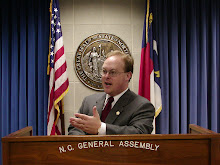 Insurance Commissioner and State Fire Marshal Wayne Goodwin announced that beginning Jan. 1, N.C. landlords were required by law to install at least one battery or electric carbon monoxide alarm on each level of each rental unit. Often called the silent killer, carbon monoxide (CO) is an invisible, odorless, colorless gas that's created when a fuel source burns incompletely.
Insurance Commissioner and State Fire Marshal Wayne Goodwin announced that beginning Jan. 1, N.C. landlords were required by law to install at least one battery or electric carbon monoxide alarm on each level of each rental unit. Often called the silent killer, carbon monoxide (CO) is an invisible, odorless, colorless gas that's created when a fuel source burns incompletely. TimeWarner NewsChannel 14 Carolina covered this story here at this link. Insurance Commissioner Goodwin told viewers:
"Most of the types of casualties and injuries and incidents occurring in the home involving carbon monoxide occur in December, January and February, which matches up when we have the coldest months of the year," State Fire Marshal Wayne Goodwin said.In 2005, municipal fire departments nationwide responded to an estimated 61,100 carbon monoxide incidents. January and December were the peak months for CO incidents and the peak time of day was between 6 and 10 p.m.
Goodwin said carbon monoxide is called the silent killer because it’s odorless and colorless and the symptoms are like having the flu.
"Every month, you should test your carbon monoxide detector and alarm,” Goodwin said. “You should make sure the detector is located at every level and also particularly outside of bedroom units in your home."
Under the new state law, landlords must ensure that the carbon monoxide appliance is operating at the beginning of each new lease. They must repair or replace the alarm within 15 days of being notified in writing of a need for repair or replacement and may be fined if they are out of compliance.
Carbon Monoxide Safety Tips and Facts
• CO alarms should be installed in a central location outside each sleeping area and on every level of the home. For the best protection, interconnect all CO alarms throughout the home so when one sounds, they all sound.
• Choose a CO alarm that has the label of a recognized testing laboratory.
• Test CO alarms at least once a month; replace them according to the manufacturer's instructions.
• If the CO alarm sounds, immediately move to a fresh air location outdoors or by an open window or door. Make sure everyone inside the home is accounted for. Call for help from a fresh air location and stay there until emergency personnel arrive.
• If you need to warm a vehicle, remove it from the garage immediately after starting it. Do not run a vehicle or other fueled engine or motor indoors, even if garage doors are open. Make sure the exhaust pipe of a running vehicle is not covered with snow.
• During and after a snowstorm, make sure vents for the dryer, furnace, stove, and fireplace are clear of snow build-up. .

• Early symptoms of CO poisoning are nausea, headache and flu-like symptoms. Prolonged exposure can lead to brain damage and even death.
Heating equipment is a leading cause of home fires during the months of December, January and February. In 2006, heating equipment was involved in an estimated 64,100 reported U.S. home structure fires. This translates to 540 deaths, 1,400 injuries, and $943 million in direct property damage.

General Heating Safety Tips
• All heaters need space. Keep things that can burn, such as paper, bedding or furniture, at least 3 feet away from heating equipment.
• Use heating equipment that has the label of a recognized testing laboratory.
• Install stationary space heating equipment, water heaters or central heating equipment according to the local codes and manufacturer's instruction. Have a qualified professional install the equipment.
• Have a professional inspect and clean fireplaces, chimneys, furnaces and other heating equipment annually.
(Above statistics provided by the National Fire Protection Association.)
It's rather telling - as North Carolina readers of the Wayne's World blog know after having the coldest weather recently in a generation - that half of all home heating fires occur in December, January and February.

In the span of a few recent weeks there were numerous reports of carbon monoxide poisonings and deaths in North Carolina. One egregious example occurred in Charlotte.
Do your part to protect you, your loved ones, and your home from "The Silent Killer."
To learn more and to keep up with this and related safety programs, go to the Office of State Fire Marshal website at this link, or www.ncdoi.com/OSFM.








